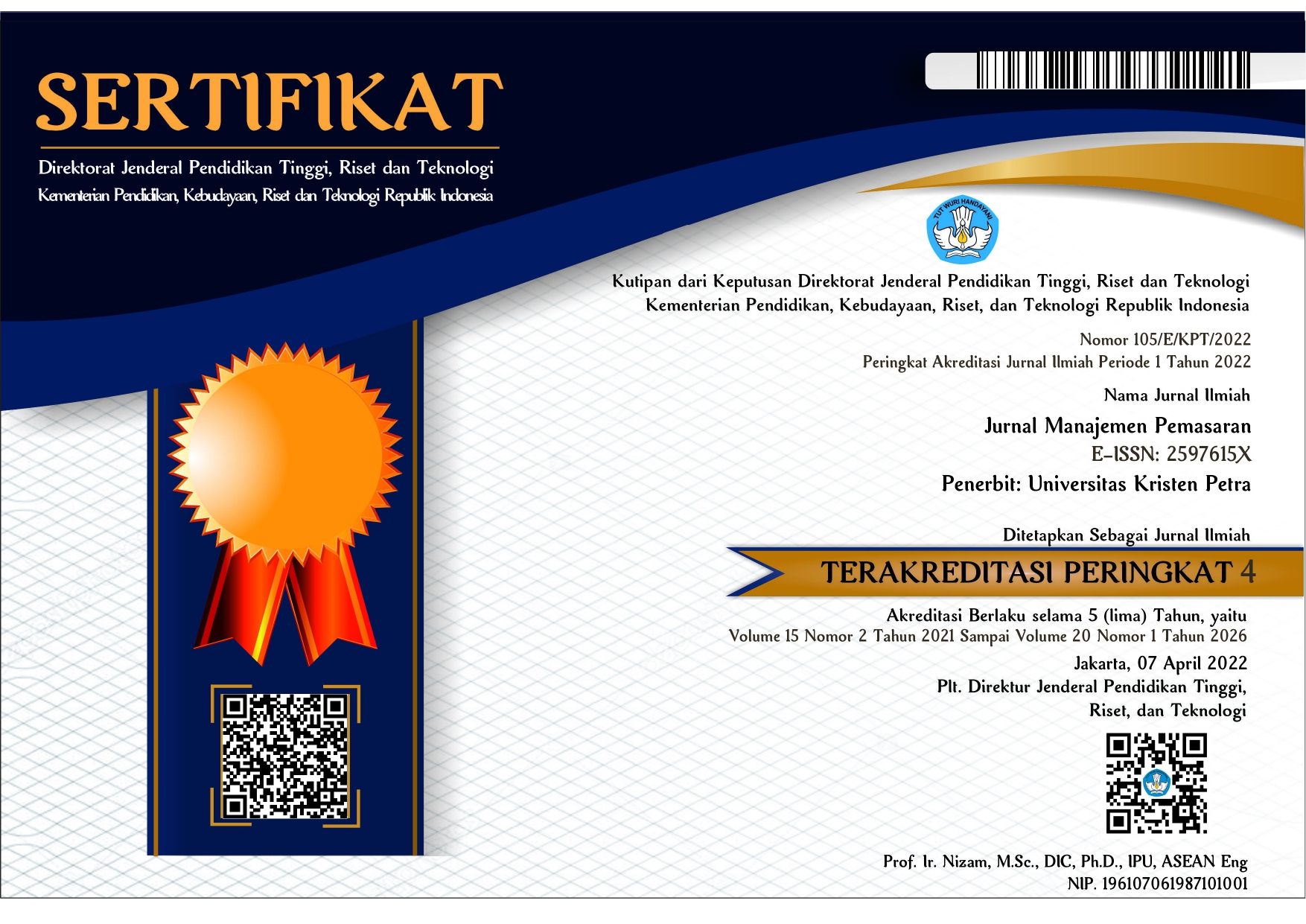VIRTUAL INFLUENCERS AND DIGITAL ENGAGEMENT
KEY INSIGHTS FROM INDONESIA'S YOUNGER CONSUMERS
DOI:
https://doi.org/10.9744/pemasaran.18.2.123-136Keywords:
virtual influencers, consumer engagement, perceived authenticity, content quality, technological sophistication, digital literacyAbstract
This study addresses a critical gap in digital marketing by examining the impact of virtual influencers on consumer engagement, focusing on Gen Z and Gen Y in Indonesia’s Jabodetabek region. While virtual influencers are gaining traction globally and locally, limited research has explored the factors that drive consumer interaction in diverse, digitally evolving markets like Indonesia. This study investigates the roles of perceived authenticity, content quality, and technological sophistication, with a particular emphasis on the moderating effect of digital literacy—a factor often overlooked in previous research. Data from 179 respondents were analyzed using Structural Equation Modeling (SEM) with SmartPLS. The findings reveal that perceived authenticity, content quality, and technological sophistication significantly enhance consumer engagement with virtual influencers, especially among digitally literate consumers. Digital literacy plays a critical moderating role, amplifying the impact of these influencer attributes and highlighting the importance of digital fluency in consumer interactions with advanced digital personas. These insights offer a theoretical contribution to the literature on influencer marketing and provide practical guidance for Indonesian brands seeking to connect with younger, tech-savvy audiences. By prioritizing authenticity, high-quality content, and appropriate technological sophistication, brands can strategically leverage virtual influencers to cultivate deeper, more meaningful engagement in Indonesia’s rapidly evolving digital landscape.
References
Audrezet, A., de Kerviler, G., & Moulard, J. G. (2020). Authenticity under threat: When social media influencers need to go beyond self-presentation. Journal of Business Research, 117, 557-569. https://doi.org/10.1016/j.jbusres.2018.07.001
Bagozzi, R. P., & Yi, Y. (1988). On the evaluation of structural equation models. Journal of the Academy of Marketing Science, 16(1), 74-94. https://doi.org/10.1007/BF02723327
Badan Pusat Statistik (BPS). (2023). Population of Indonesia by age group. Retrieved from https://www.bps.go.id/
Belanche, D., Casaló, L. V., Flavián, C., & Ibáñez-Sánchez, S. (2021). Building brand engagement through interactions with AI: The role of perceived personalization. Computers in Human Behavior, 124, 106912. https://doi.org/10.1016/j.chb.2021.106912
Chuah, S. H.-W., El-Manstrly, D., Tseng, M.-L., & Ramayah, T. (2021). Impact of digital literacy on the acceptance and usage of social media for virtual influencers in tourism: Moderating role of knowledge acquisition. Technological Forecasting and Social Change, 177, 121501. https://doi.org/10.1016/j.techfore.2021.121501
Deci, E. L., & Ryan, R. M. (1985). The general causality orientations scale: Self-determination in personality. Journal of research in personality, 19(2), 109-134.
Djafarova, E., & Trofimenko, O. (2019). ‘Instafamous’–credibility and self-presentation of micro-celebrities on social media. Information, Communication & Society, 22(10), 1432-1446. https://doi.org/10.1080/1369118X.2018.1438491
Fornell, C., & Larcker, D. F. (1981). Evaluating structural equation models with unobservable variables and measurement error. Journal of Marketing Research, 18(1), 39-50. https://doi.org/10.2307/3151312
Hair, J. F., Hult, G. T. M., Ringle, C. M., & Sarstedt, M. (2019). A primer on Partial Least Squares Structural Equation Modeling (PLS-SEM) (2nd ed.). SAGE Publications, Inc. https://doi.org/10.1007/978-3-030-80519-7
Hughes, C., Swaminathan, V., & Brooks, G. (2019). Driving brand engagement through online social influencers: An empirical investigation of sponsored blogging campaigns. Journal of Marketing, 83(5), 78-96. https://doi.org/10.1177/0022242919854374
HypeAuditor. (2023). The rise of virtual influencers: What to expect in 2023. Retrieved from https://hypeauditor.com/blog/the-rise-of-virtual-influencers-in-2023/
Laimeheriwa, I. B., & Kembau, A. S. (2024). Pengaruh kepercayaan akan simulasi virtual try on terhadap niat beli di e-commerce. Syntax Literate; Jurnal Ilmiah Indonesia, 9(1), 241-257. https://doi.org/10.36418/syntax-literate.v9i1.4236
Leung, X. Y., Tanford, S., & Liu, Z. (2021). Virtual influencers: Exploring how consumers perceive their roles in influencer marketing. Journal of Hospitality and Tourism Technology, 12(2), 345-360. https://doi.org/10.1108/JHTT-10-2019-0116
Nguyen, T., Park, S., & Kang, J. (2021). Digital literacy and the online shopping experience: A customer segmentation approach. Journal of Business Research, 124, 605-616. https://doi.org/10.1016/j.jbusres.2020.09.057
Park, J., & Kang, B. S. (2020). A study on the development of media information literacy concept and educational contents. Journal of Korean Library and Information Science Society, 51(3), 223-250.
Schouten, A. P., Janssen, L., & Verspaget, M. (2020). Celebrity vs. influencer endorsements in advertising: The role of identification, credibility, and Product-Endorser fit. International Journal of Advertising, 39(2), 258-281. https://doi.org/10.1080/02650487.2019.1634898
Schwemmer, C., & Ziewiecki, S. (2018). Social media sellout: The increasing role of product promotion in influencer marketing. Social Media + Society, 4(3), 1-20. https://doi.org/10.1177/2056305118790761
Statista. (2023). Global digital influencer marketing market size from 2020 to 2023. Retrieved from https://www.statista.com/statistics/1092818/global-influencer-market-size/
Sung, Y., Kim, S., & Choi, S. M. (2021). Consumers’ responses to social media influencers: The effects of influencer type, advertising disclosure, and brand message. Journal of Retailing and Consumer Services, 63, 102726. https://doi.org/10.1016/j.jretconser.2021.102726
Venness, V., Kembau, A. S., & Felix, A. (2022). Pengaruh mediasi brand image pada brand ambassador, event marketing dan social media marketing terhadap minat beli di Blibli. Syntax Literate; Jurnal Ilmiah Indonesia, 7(12), 20325-20335.
Wang, W., Zhou, Q., & Li, H. (2022). Virtual influencers: A qualitative study on consumer perceptions and their influence on brand attitudes. Journal of Consumer Marketing, 39(3), 297-306. https://doi.org/10.1108/JCM-07-2021-4777
Wardhana, A., & Yulia, Y. (2020). Pengaruh kemudahan penggunaan, nilai tidak tergantikan,kualitas sistem, kesadaran teknologi dan desain visual terhadap positif word of mouth dan niat pembelian ulang dengan mediasi loyalitas merek. Managament Insight: JurnaI lmiah Manajemen, 15(1), 65-77
We Are Social & Hootsuite. (2023). Digital 2023: Indonesia report. Retrieved from https://datareportal.com/reports/digital-2023-indonesia
Downloads
Published
How to Cite
Issue
Section
License
Copyright (c) 2024 Agung Stefanus Kembau, Arifmanuel Kolondam, Nancy Henrietta Jessamine Mandey

This work is licensed under a Creative Commons Attribution 4.0 International License.

















